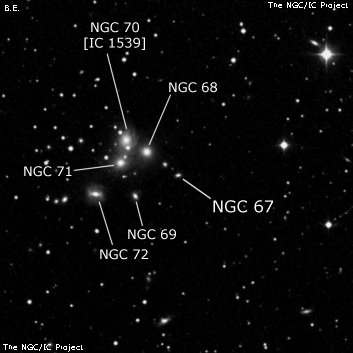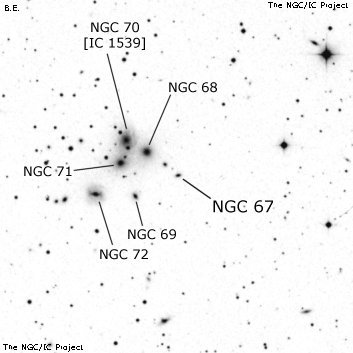NGC/IC Project Restoration Effort
(This is a very very beta version)
NGC67


Basic Information
Location and Magnitude
Right Ascension: 0:18:14.9
Declination: +30:3:48
Constellation: AND
Visual Magnitude: 14.2
Historic Information
Discoverer: Mitchell
Year of discovery: 1855
Discovery aperture: 72.0
Observational
Summary description: eF, vS, R
Sub-type: E3
Corwin's Notes
=====
NGC 67 is the westernmost and faintest of at least seven nebulae found by LdR
in what we now call the NGC 68 group. His fine sketch, published in his 1861
monograph, clearly shows that the object that most of us have been calling
NGC 67A is, in fact, the object LdR sketched as one of the nebulae. The
object we've been calling NGC 67 is shown on LdR's sketch as a star. So, I've
reassigned NGC 67 to the correct galaxy to properly reflect the history.
The other NGC objects in the group (N68, 69, 70, 71, 72, and 74) are brighter
and have been correctly identified in the major catalogues.
Steve's Notes
=====
NGC 67
24" (9/15/12): very faint, very small, round, 12"-15" diameter, just visible continuously. This galaxy is at the west end of the NGC 68 group and on a line extending northeast with PGC 1185, NGC 68 and NGC 70 with each galaxy separated from the next by less than 1'. PGC 1185, misidentified in most catalogues as NGC 67 and the faintest galaxy in the central region, is situated just 44" NE. PGC 1185 appeared extremely faint and small, 8" diameter.
18" (11/14/09): this galaxy and PGC 1185 were the faintest members viewed in the NGC 68 group. NGC 67 appeared as a mag 16 threshold glow 1.7' SW of NGC 68. It required averted to occasionally glimpse, though a few times I could tell it was elongated. In a 22" scope, I was able to hold this galaxy continuously at over 400x.
PGC 1185 was occasionally glimpsed as a threshold "star" sandwiched between this galaxy and NGC 68 (0.8' from both galaxies). Most sources identify PGC 1185 as NGC 67 and this galaxy as NGC 67A or anonymous although it was clearly shown on Rosse's sketch of the field. The identification is corrected on the NGC/IC Project site.
17.5" (8/27/87): extremely faint and small. First in the NGC 68 group of 9 with NGC 68 0.9' NE, NGC 69 1.8' SE and NGC 71 1.9' E. This observation may apply to NGC 67 or PGC 1185 very close NE.



